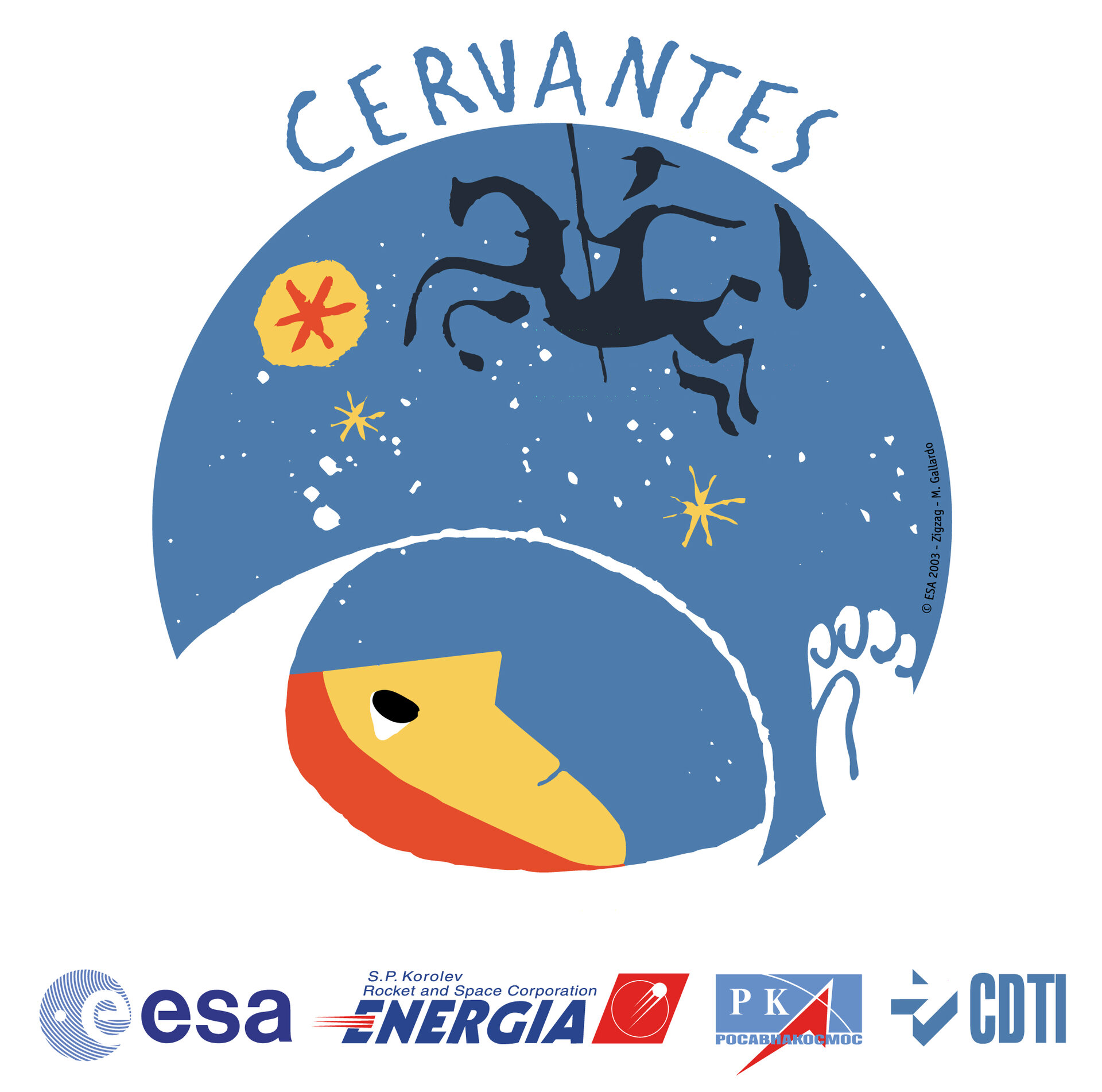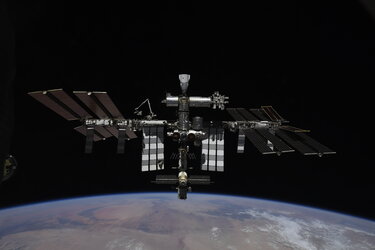Cervantes
Soyuz TMA-3 is a Russian spaceflight mission to the International Space Station (ISS).
It was the third flight for the TMA modification of the Soyuz spacecraft, and the 7th Soyuz to fly to the ISS.
MISSION STATISTICS
Mission name: Soyuz TMA-3
Call sign: Ingul
Spacecraft: Soyuz TMA-3
Number of crew members: 3
Launch:
18 October 2003, 05:38:03 UTC, Baikonur LC1
Contact with ISS: 20 October 2003, 07:16 UTC
Undocked from ISS: 29 April 2004, 20:52 UTC
Landing:
30 April 2003, 00:11:15 UTC, 50.38° N; 67.20° E
Duration: 194 days, 18 hours, 33 minutes, 12 seconds
Number of orbits: ~3 170
CREW
Launched and landed ISS Expedition 8 crew:
- Alexander Kaleri (4) - Russia
- Michael Foale (6) - United States
Launched:
- Pedro Duque (2) - ESA Spain
Landed:
- André Kuipers (1) - ESA Netherlands
(1) number of spaceflights each crew member has completed, including this mission

MISSION HIGHLIGHTS
Soyuz TMA-3 is a Russian spaceflight mission to the International Space Station, the third flight for the TMA modification of the Soyuz spacecraft, and the 7th Soyuz to fly to the ISS. The commander of the Soyuz is Alexander Kaleri (Russia). The flight engineer is Michael Foale (USA), and Pedro Duque from Spain is serving as the second flight engineer. After docking with the ISS they exchanged the current crew on ISS and became the eighth station crew, called 'ISS Expedition Eight'.
During the stay on the station Michael Foale is the ISS Commander, while Alexander Kaleri is the engineer. Foale is the first American to have served on both Mir and the ISS. Pedro Duque performed some ESA sponsored science experiments under the mission name Cervantes and then returned with the ISS 7 crew on Soyuz TMA-2.
The backup crew was William McArthur, Valery Tokarev and André Kuipers. Foale and Kaleri along with André Kuipers, the third seater from TMA-4 landed on 29 April 2004, near Arkalyk, Kazakhstan. A minor helium leak did not affect their mission.
Why 'Cervantes'?
Miguel de Cervantes is without doubt the most international Spanish writer. Therefore, there could not be a better name for a mission to the International Space Station with so much Spanish involvement. The Cervantes Mission will contribute to further internationalizing Spanish science and technology.
Moreover, the 'symbolic objects' that will fly in the Cervantes Mission will include an edition of Don Quixote on CD. On its return, a seal with the signatures of the Mission crew members will certify that this CD and the other 'symbols' were actually on the Space Station.
Mission objectives
Spanish ESA astronaut Pedro Duque, will fly into space in the framework of the Spanish Soyuz mission 'Cervantes'. His 10-day flight will include 8 days on the International Space Station. The Spanish Ministry of Science and Technology, through the Centre for Development of Industrial Technology (CDTI), sponsored the mission within the framework of an agreement between ESA and Rosaviakosmos. The principle objectives of the mission are:
To carry out a full scientific experiment Programme - ESA's astronaut Pedro Duque will carry out a full scientific programme, spending some 40 hours of his eight days on the ISS on experimental activity. Most of the experiments are sponsored by the Spanish government although there are also a number of reflights of experiments from the Belgian Odissea mission to the ISS in October 2002.
Duque will also participate in a number of educational and promotional activities with the aim of bringing the European human space programme and research performed in space to a wider public, and young people in particular.
To increase operational experience aboard the ISS - From a European perspective the Cervantes mission is important because it increases ESA’s astronaut experience ahead of the launch of Columbus, Europe’s own laboratory to the Space Station. Pedro Duque has worked previously on the development of Columbus. He reviewed its design in terms of operability and maintainability and checked on ergonomic aspects of its structure. The ongoing development of Columbus and its research facilities will benefit from the ‘hands on’ experience Pedro will get during his stay on the ISS.
To exchange the station lifeboat: the Soyuz TMA-2, for the Soyuz TMA-3 - The Soyuz TMA spacecraft act as a lifeboat for the ISS for use in emergency situations. These are exchanged every six months to maintain the integrity of the on-board systems. The Soyuz TMA-2 spacecraft, which bought the ISS Expedition 7 crew to the International Space Station in April, will be exchanged for the Soyuz TMA-3, which will bring Pedro Duque and the ISS Expedition 8 Crew to the ISS. The Soyuz TMA-2 spacecraft will return with Pedro Duque and the Expedition 7 crew.
- To exchange the current ISS Expedition 7 crew for the ISS Expedition 8 crew - In light of the Columbia accident in February 2003, the Soyuz TMA spacecraft are currently acting as the crew exchange vehicles for the ISS permanent crews. The current Expedition 7 crew of Edward Lu and Yuri Malenchenko arrived on the ISS on 28 April 2003. They will return with ESA astronaut Pedro Duque at the end of his 8-day stay on the ISS. The expedition 8 crew will be stationed on the ISS for approximately 6 months and will return with ESA astronaut André Kuipers as part of his mission to the ISS in the April of 2004.








